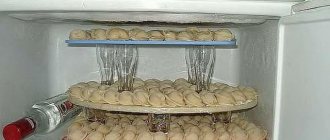Buckwheat, even after cooking, retains all its taste and nutritional properties. Nutritionists advise using it 2-3 times a week to prevent various diseases of systems and organs. The porridge cooks quite quickly - only 20 minutes, but housewives often make mistakes with the proportions of the product and the family is not able to consume all the porridge at one time. Then the buckwheat is stored in the refrigerator. The shelf life largely depends on the method of preparing the cereal; it can vary from a day to a week. In order to preserve the taste and beneficial properties of buckwheat porridge as much as possible, it is important to follow storage rules.
How long does buckwheat last in the refrigerator?
The duration of its storage depends on the presence of various additives in the composition.
Separately, it should be noted that popular baby buckwheat porridges for first feeding (both dairy and dairy-free) from brands such as Fleur Alpin, Heinz, Nestle, Frutonyanya, Malyutka are prohibited from being stored after preparation. Always brew only a fresh portion for your baby, immediately before meals.
If buckwheat without additives
The low temperatures of the refrigeration chamber allow you to preserve the nutritional value of boiled buckwheat, without foreign impurities and additives, for 3 days.
The container with cereal should be tightly closed with a lid so as not to absorb foreign odors and not become airy. Before placing in the refrigerator, the dish must be cooled naturally.
The appearance of an unpleasant sour smell and mucus at the bottom of the pan indicates spoilage of the product. To prevent this from happening, after cooking it is worth keeping the porridge in the refrigerator for 2-3 days, observing the rules of the commodity neighborhood and sanitary standards. You should also know that buckwheat quickly absorbs odors and impurities from the air.
If buckwheat with additives
Buckwheat porridge, to which meat, butter, kefir, milk, chicken, stew, minced meat, and mushrooms have been added, spoils faster.
At a temperature of +2+4°C, the container will stay in the refrigerator for no more than a day.
How to store boiled buckwheat
It is preferable to use containers made of glass or ceramics; an enamel pan or food-grade plastic will do. It is not recommended to keep the product in an aluminum container - it can oxidize, providing buckwheat with harmful compounds.
The freshness of the finished dish is affected by the air humidity in the room. It should not be more than 75%, otherwise the product will begin to deteriorate faster and become watery and tasteless.
The initial quality of the cereal is of no small importance. Small, split grains with an admixture of weed seeds, dirt, and dust will not produce tasty porridge, as well as if the expiration dates have been violated. Whole clean grains after cooking will become a healthy and nutritious dish.
How long does buckwheat last at room temperature?
A room temperature of +18+25°C will preserve the nutritional value of boiled buckwheat for 4-6 hours.
After this period, it is not recommended to eat the dish. If the refrigerator breaks down or the power goes out, you should take the product out onto the balcony (if the temperature allows). In this case, it is necessary to ensure that the container is insulated from direct sunlight, precipitation, dust, insects, and to prevent weathering. Alternatively, you can place the product in a vacuum bag and immerse it in cold water: this will extend the shelf life to 24 hours.
Rules and terms for storing boiled buckwheat
Buckwheat is a healthy and nutritious product. In order for it to bring only benefits, it is important to comply with storage conditions. The shelf life of boiled cereal depends on the temperature. In the heat it is minimal and does not exceed 3 hours; the freezer allows you to extend it up to 21 days.
Simple porridge without additives costs the longest. Milk, sugar, butter and meat reduce storage time by several hours. Salt is a natural preservative, therefore it helps to increase the time interval within which the dish needs to be consumed.
Boiled buckwheat can be kept in the refrigerator, cellar, freezer or on the balcony. If you leave it warm, the storage period will be very short.
In a refrigerator
The optimal temperature for preserving the shelf life of porridge is from 0 to +4°C. Refrigerator storage rules:
- Use dishes made of glass, ceramics or metal coated with enamel. The lid should fit snugly against the edges of the container.
- Do not place foods with a strong odor nearby - fish, smoked meats, lemons, dishes with garlic, spices, etc.
- If you have a large amount of buckwheat porridge, you need to immediately freeze the excess. If you keep them in the cold and then put them in the freezer, the taste, aroma and beneficial properties will be preserved worse.
The shelf life of boiled buckwheat in the refrigerator does not exceed 3 days. On the 4th day an unpleasant damp smell appears, by the 5th day the dish deteriorates and becomes unfit for consumption.
Without refrigerator
Porridge should be stored in the cold. When warm, it quickly begins to turn sour and “suffocate.” If you leave boiled cereal on the kitchen table, it will turn sour in 3-4 hours; if the product was cooked with milk or meat, it will turn sour even faster.
How long can boiled buckwheat be stored without a refrigerator after it has completely cooled, depending on the room temperature:
- +9-14°С – 8 hours;
- 15-20°C – 5 hours;
- 21°C and above – no more than 3 hours.
The container must be closed with a lid. This makes it more difficult for microorganisms to get inside and spoil the dish.
If the refrigerator is broken, there is no balcony, but there is a cellar, then the hot porridge can be taken there, having first wrapped it well. It will cool slowly - the shelf life will increase. This is especially true for rural areas or cottages. In a cool room, buckwheat cooked in the morning will last until late in the evening.
On the balcony
When the outside temperature does not exceed +5°C, boiled cereal can be placed on an open balcony for 2-3 days.
If the thermometer shows +6-8°C, then the storage time is reduced to 1 day. In warmer weather (up to +15°C), you should not leave the product for more than 8 hours.
Buckwheat is taken out in the pan in which it was boiled, or in a glass jar. Any container must be tightly closed. If the balcony receives direct sunlight, cover the container with a light cloth
An air temperature of +15°C does not imply storage on the balcony.
Is it possible to freeze
If necessary, boiled buckwheat can be frozen. To do this, place it in a plastic container, close it with a lid, and put it in the freezer.
If there is not enough space in the compartment, pour the porridge into 2 plastic bags and place it on the middle shelf of the freezer. This way the taste and smell will be completely preserved. Storage temperature – -12 °C and below, period – up to 3 weeks.
The shelf life of buckwheat porridge is presented in the table:
| Place | Temperature, °C | Term |
| Fridge | from 0 to +4 | 3 days |
| Balcony | up to +5 | 2-3 days |
| +6-8 | 1 day | |
| up to +15 | no more than 8 hours | |
| Room | +9-14 | 8 ocloc'k |
| 15-20 | 5 o'clock | |
| 21 and above | 3 hours | |
| Freezer | -12 and below | up to 21 days |
How long does buckwheat last in a closed package?
According to general rules, buckwheat can be stored in a closed package for 2 years.
The timing may vary depending on the type of grain product:
- The kernel retains its nutritional value for 15-20 months.
- The product must be used within 14-18 months.
- Green buckwheat must be consumed within 15 months.
At the same time, important factors that can shorten the shelf life of products are:
- Violation of the tightness of the container.
- Incorrect temperature conditions (not in the range of +5+25 degrees).
- Relative humidity level is more than 75%.
- Exposure to direct sunlight.
When purchasing, pay attention to the product labeling, which reflects the date the cereal was packaged. According to GOST, the shelf life of products is set by the manufacturer. For core and product, it cannot exceed 15 and 14 months (with regards to the Far East, North Caucasus, Lower Volga region), for other regions - no more than 18-20 months.
Influencing factors
Buckwheat can truly be called one of the healthiest cereals. Its preparation takes literally a third of an hour. And in some cases there is no need to even cook buckwheat. It is enough to fill it with lukewarm water or kefir at room temperature. In a few hours, the kernels will swell and be ready for use.
Component composition:
- ferrum;
- cellulose;
- retinol;
- manganese;
- selenium;
- vitamins from group B;
- calcium;
- tocopherol;
- magnesium;
- nicotinic acid, etc.
If you want all these components to remain in buckwheat after it has been cooked, you need to take into account the factors that affect the shelf life of the cereal.
Main factors:
- quality of cereal;
- package;
- best before date.
As a rule, the manufacturer indicates on the package information about the date of packaging of buckwheat and its shelf life. Do not choose cereals that have been manufactured for a long time. Firstly, it may have a bitter taste. Secondly, the longer the cereal is stored, the less useful it remains.
The shelf life of cereals, both raw and boiled, will be affected by packaging. It must be hermetically sealed and complete. In the transparent plastic packaging you can see the quality of the kernels. Too much garbage indicates that the grain is not of very high quality. It is better to give preference to selected kernels.
Signs of spoiled buckwheat
To identify spoiled or expired products, you need to know what points to pay attention to:
- When purchasing, you should evaluate the integrity of the packaging and look at the production date. If the shelf life is coming to an end, it is better to refuse such a purchase;
- The color should be brown, without the presence of a white coating or traces of mold;
- A smell that gives off notes of mustiness and rancidity indicates a delay;
- Unsuitable buckwheat tastes bitter;
- Upon careful examination of the kernel, various insects are found (larvae, mucoeds, worms);
- If stored in rooms with high humidity levels, the product may become damp. A damp product can be identified by the grains clumping into lumps.
When should you not eat buckwheat?
The shelf life of the product depends on the preparation method and additives. Buckwheat, cooked in water without oil, lasts the longest. Ready-made porridge does not tolerate heat. At temperatures from +8°C and above, bacteria begin to rapidly multiply in it. You can tell if buckwheat has gone bad:
- by unpleasant odor;
- sour and rancid taste;
- mold;
- mucus.
The presence of at least one of the listed signs indicates that the porridge should not be consumed. There is no need to try to save the product by boiling, frying or using seasonings.
Lifehacks for storing buckwheat
- The product must be poured from industrial containers into an airtight container. As a rule, the kernel is sold in plastic packaging, which is easily torn: the contents may be damaged and subject to insect attack. For storage at home, a glass or metal jar with a lid or a bag made of natural fabrics, which must first be boiled in a strong salt solution, is suitable.
- Before packaging, the product should be thoroughly sifted and dried in the oven.
- A clove of garlic or a bay leaf placed in a container will help prevent the appearance of beetles.
- The location for storing supplies should be dark and dry.
- Do not place containers with buckwheat in the same box with products that have a strong odor, since the grain quickly absorbs other people's aromas.
How much and how to store raw cereals
The shelf life of buckwheat depends not only on the initial quality of the product, but also on the conditions in which it is placed after purchase. In sealed factory packaging, the kernel remains usable for 15-20 months. Duration - from 14 to 18 months.
After opening the package, the kernel must be eaten within 4 months. The lifespan was 3 months.
It is quite possible to preserve the properties of buckwheat throughout its shelf life if the following conditions are met:
- Buckwheat purchased by weight should be immediately transferred to a container made of glass, metal or food-grade plastic with a tight-fitting lid. Or put it in a canvas bag with drawstrings. If the cereal was sold hermetically sealed, it should be poured into a suitable container immediately after opening. It is not recommended to keep it in a plastic bag for a long time. In such a container, especially at high humidity and temperature, it will “suffocate” and go rancid.
- Place the bag or container of cereal in a dark pantry or closet. It is not recommended to store jars of buckwheat in the light. In hot weather, condensation may form in them and the kernels will go rancid. The optimal temperature for storing the product is 5-25°.
Nutrients are fully preserved in buckwheat for about 8 months. After 12 months cereals lose them almost completely.
For fans of healthy eating, they sell green buckwheat, which is not boiled, but sprouted and steamed with boiling water. This product can be stored in packaging for 15 months; if opened, it does not lose its beneficial properties for 2 months.
The main “enemies” of buckwheat are dampness and insects. How to deal with them?
- If the humidity in the room where the cereal will be stored exceeds 60-70%, it is better to dry the kernels additionally. This can be done by laying them out in one layer on a baking sheet and placing them in an oven preheated to 160° and turned off for 10 minutes.
- To prevent the kernels from becoming damp, they are placed in dry linen bags, boiled in a concentrated saline solution (130 g of salt per 3 liters of water). If the cereal is poured into a jar, before placing it, place a small bag of thin cotton or gauze filled with salt on the bottom.
A few bay leaves or unpeeled garlic cloves will keep insects away from the cereal.
Buckwheat should not be stored next to coffee and spices. The cereal will absorb the odors of these products and will be tasteless after cooking.
The dangers of eating expired buckwheat
It is permissible to eat buckwheat that has expired, if inspection does not reveal signs of spoilage such as a strong unpleasant odor, change in taste, or traces of insect activity. But we still recommend using fresh products in cooking in order to eliminate the risk of poisoning.
If we are talking about a ready-made dish (for example, buckwheat cooked in a slow cooker), then after 48 hours the irreversible process of reproduction of pathogenic organisms begins, so it is better to dispose of such food.
Storing green buckwheat
Nowadays, when healthy eating is very important, eating green buckwheat is becoming increasingly popular. But this raises a new problem - how to store green buckwheat? After all, it is not subjected to heat treatment, like brown cereals.
The taste of green buckwheat is reminiscent of nutty, while it contains a large amount of minerals and vitamins, but requires certain storage rules.
Places for storing green buckwheat should be dry and cool. Bright light can negatively affect the consumer qualities of this product. Therefore, cereals should be kept in a dark cupboard or pantry.
To prevent the bulk product from becoming covered with mold and acquiring a musty smell during long-term storage, it is better to keep it in a linen bag where it can “breathe.”
How to choose quality cereals
Before you figure out how to store buckwheat, you need to choose it correctly. When choosing cereal in a store, you are faced with several varieties:
- Yadritsa - grains in the form of pyramids. Used for cooking for half an hour.
- Prodel - crushed kernels, cooks faster, 15-20 minutes is enough.
- Green – unprocessed buckwheat, can be steamed with boiling water and sprouted.
- Flakes, Smolensk - highly crushed, does not require cooking, steamed with boiling water or hot milk.
- Flour is ground grain used for baking and making drinks.
In the store, pay attention to the following nuances:
- Choose cereals without debris, husk residues, pebbles, bugs and other insects. All this is visible through the transparent packaging.
- The grains must be the same size. Otherwise, it will not be possible to cook crumbly porridge: part of it will be ready, while the other will remain raw.
- Give preference to cereals packaged in hermetically sealed bags. Weighed products are more quickly affected by pests.
- The dark color of buckwheat indicates that it has been fried. This means that some of the beneficial substances have already been lost.
- It is advisable to choose a product of the highest and first grade. It is not treated with pesticides during cultivation, so it can be safely given to children.
Do you know that…
According to GOST, buckwheat does not have the “Extra” grade, etc. These are inventions of unscrupulous producers. There is the highest, first, second and third. But the product has no varieties at all.
Shelf life of dry buckwheat
For buckwheat, in accordance with GOST R55290-2012, the manufacturer is obliged to establish a nominal shelf life, which is calculated from the day the product is manufactured according to standard technology. In accordance with it, the seller has the right to sell the product, but when it has expired, the presence of such buckwheat on the counter is unacceptable and may entail liability, including criminal liability.
SanPiN 2.3.2.1324-03 regulates that if cereals are packaged in consumer bags or other containers during sale, for example, by weight, then its shelf life should not be longer than the original one indicated on the shipping container. Moreover, it starts not from the date of packaging, but from the time of manufacture. In general, the period during which cereals can be consumed may vary among different manufacturers. The exact time depends on the quality of the original product, the type of its packaging, production technology, as well as the sanitary regime established during its production.










